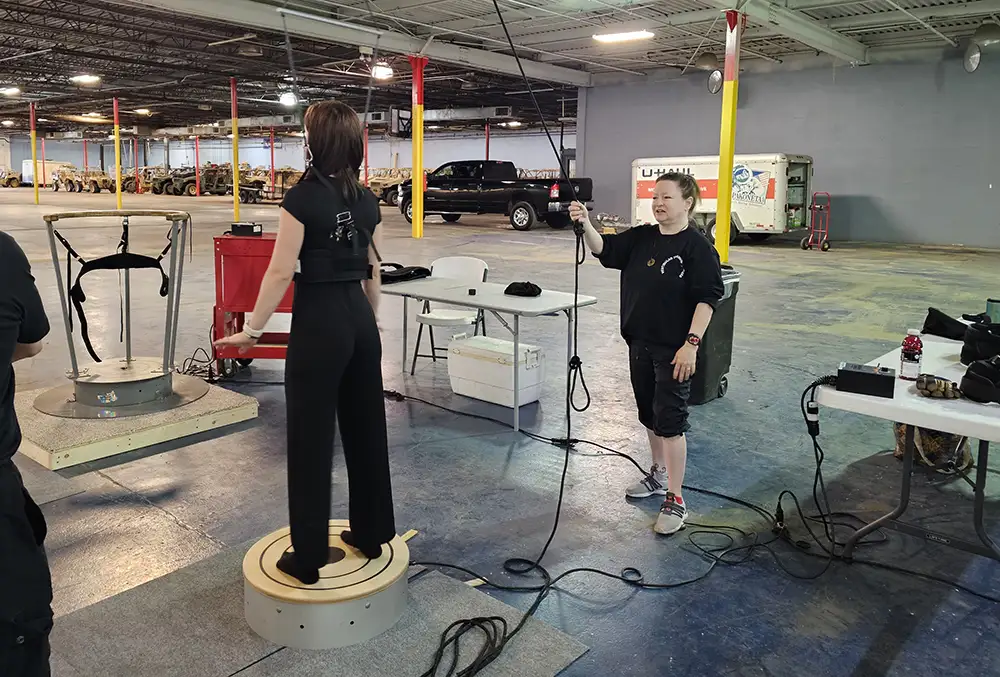Industry Applications
Physical Therapy
The non-invasive Rail Unit is showing significant potential as a therapeutic tool for physical therapists treating vestibular disorders and vertigo. Rotation therapy has been demonstrated to improve a range of functions, including the vestibular ocular reflex, balance, proprioception, spatial awareness, and communication pathways between the vestibular nuclei and the rest of the body.
Personal Training
Personal trainers can enhance their training programs and gain a competitive edge by incorporating vestibular training through controlled spinning. Both the VTS Flyer and Rail System can be seamlessly integrated into existing workouts, combining strength, proprioceptive, and vestibular exercises.
Offering spin sessions as a value-added service or a stand-alone experience presents a unique opportunity to attract and retain clients while optimizing their overall fitness and well-being.
Military
Studies show that spin training for military special operatives can significantly improve their ability to recover from disorientation. In combat situations where rapid re-orientation can be the difference between life and death, spin training is not merely an option, but a crucial element of preparation for military personnel.
Aging
As we age, the vestibular nucleus can become deconditioned, leading to slower recovery from trips and stumbles. Controlled spinning can help recondition the vestibular nucleus by stimulating underutilized neural pathways, potentially reducing the risk of falls in the elderly. Even slow, comfortable rotations can yield significant improvements in balance and stability.
Post Concussion
Controlled rotation is emerging as a promising treatment modality for concussion. The Mid Atlantic Concussion Alliance in Hockessin, DE, is currently evaluating its effectiveness, with overwhelmingly positive feedback from both patients and staff.
Preliminary results indicate improvements across the board in sway and vestibular ocular reflex (VOR) tests. While these findings are encouraging, further research is necessary to fully understand the benefits of controlled rotation in concussion recovery.
Autism
Spinning, as a form of sensory stimulation, is sometimes incorporated into therapeutic interventions for individuals with autism spectrum disorder (ASD) who experience atypical sensory processing.
These interventions fall under the umbrella of sensory integration techniques, aiming to provide specific types and amounts of sensory input to help regulate sensory processing and improve self-regulation and focus. For some individuals with autism who may be over- or under-responsive to sensations, controlled spinning can provide vestibular input, stimulating the sense of balance and movement.
Studies suggest that using a framed or overhead harness-based spinner can facilitate positive changes in many individuals with autism. Spinning may be integrated into occupational therapy sessions or sensory rooms, as part of individualized plans that include various sensory activities. However, it’s important to note that the effectiveness of spinning, or any sensory intervention, varies from person to person.
While beneficial for some, others may not respond positively or find it overwhelming. Therefore, consulting with a healthcare professional, such as an occupational therapist or qualified specialist, is crucial to assess individual sensory needs and determine appropriate, tailored interventions.
For children and adults with autism or sensory processing challenges, consistent sensory input, facilitated through fun and active techniques like those offered by Vestibular Training Services, can support daily functions and activities.
Our non-invasive equipment and training methods stimulate the vestibular system through key mechanisms, including midline crossing (activating both sides of the brain), balance training, enhanced proprioception (body awareness), and vertical axis stimulation.

